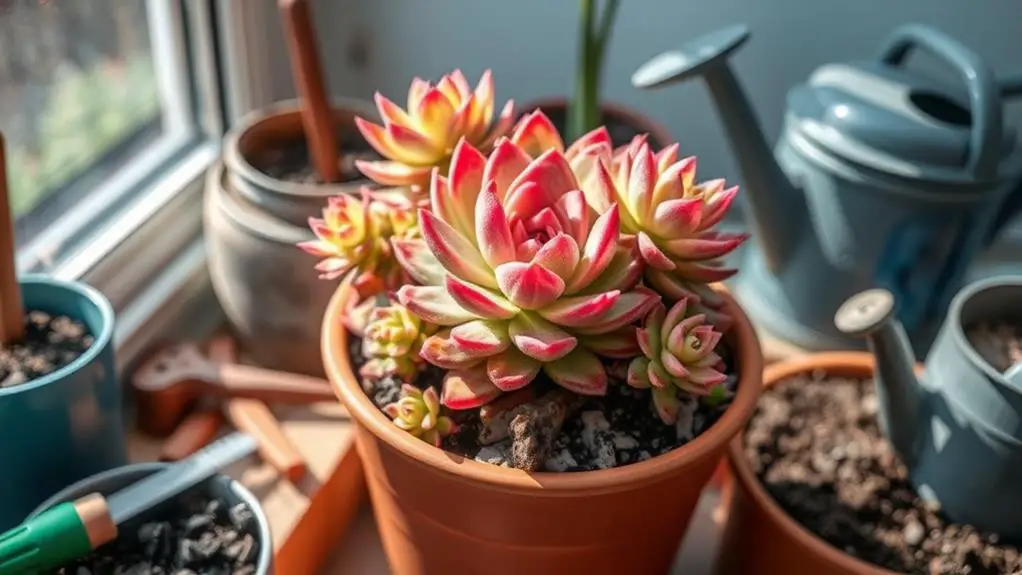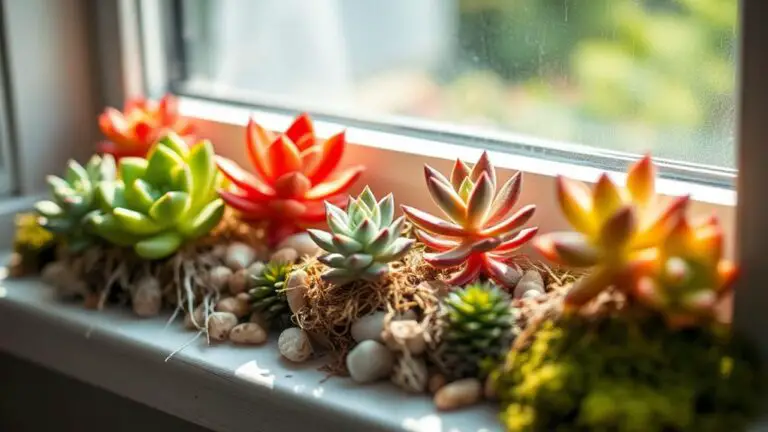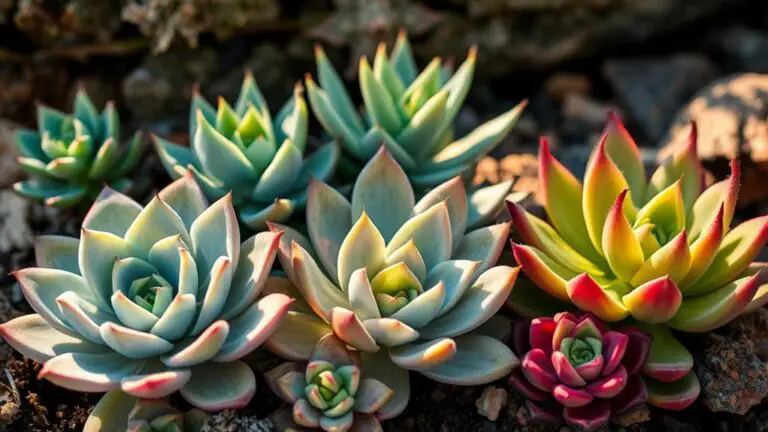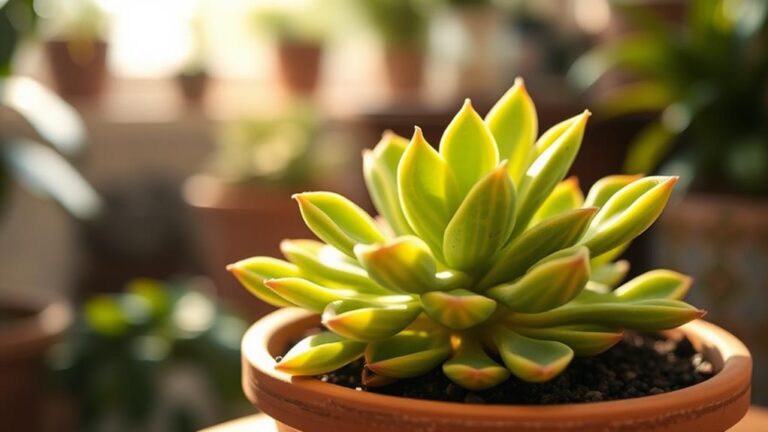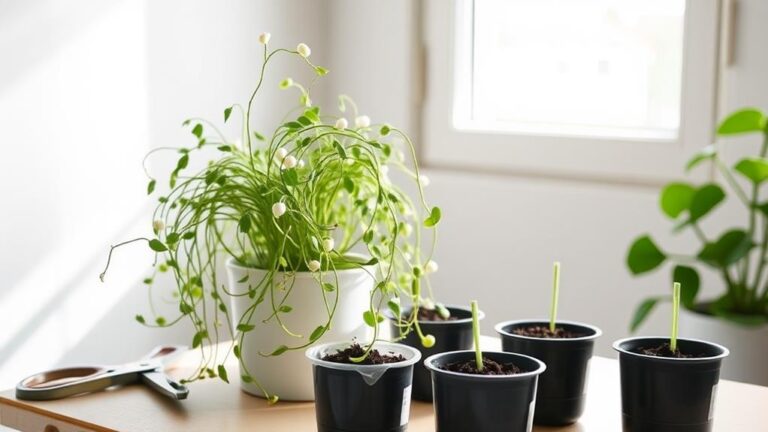How to Care for Anacampseros Telephiastrum Sunrise – A Complete Guide
Caring for Anacampseros Telephiastrum Sunrise isn't overly complicated, but it does require some specific steps to guarantee your plant thrives. You'll need to focus on light, water, soil, and temperature to give it the best environment. For instance, providing bright, indirect light for 4-6 hours daily is essential, while watering sparingly helps the soil dry out completely between waterings. But there's more to it than just light and water. How do you choose the right soil? What temperature range is ideal? Let's explore these aspects to reveal the full potential of your Anacampseros Telephiastrum Sunrise.
Light Requirements

To guarantee your Anacampseros telephiastrum Sunrise thrives, it needs bright, indirect light for at least four to six hours each day. Ensuring ideal growth for this lovely succulent involves understanding its light requirements.
Place your plant near south or west-facing windows where it can receive filtered sunlight. This positioning helps avoid the harsh afternoon sun that might cause leaf sunburn.
Morning sun is particularly beneficial. It provides gentle light that promotes healthy growth without the risk of damage. If you notice discoloration or fading in your plant's leaves, gradually acclimate it to increased sunlight exposure. This method helps prevent stress and allows the plant to adjust without harm.
Always monitor for signs of stress, such as changes in color or texture.
In indoor settings, if natural light is insufficient, especially during the winter months, consider using grow lights. These lights can simulate the bright indirect light your Anacampseros telephiastrum Sunrise needs.
Ensuring a minimum of four to six hours of light daily is essential. By carefully meeting these light requirements, you'll support your plant's health and enjoy its vibrant beauty year-round.
Watering Guidelines
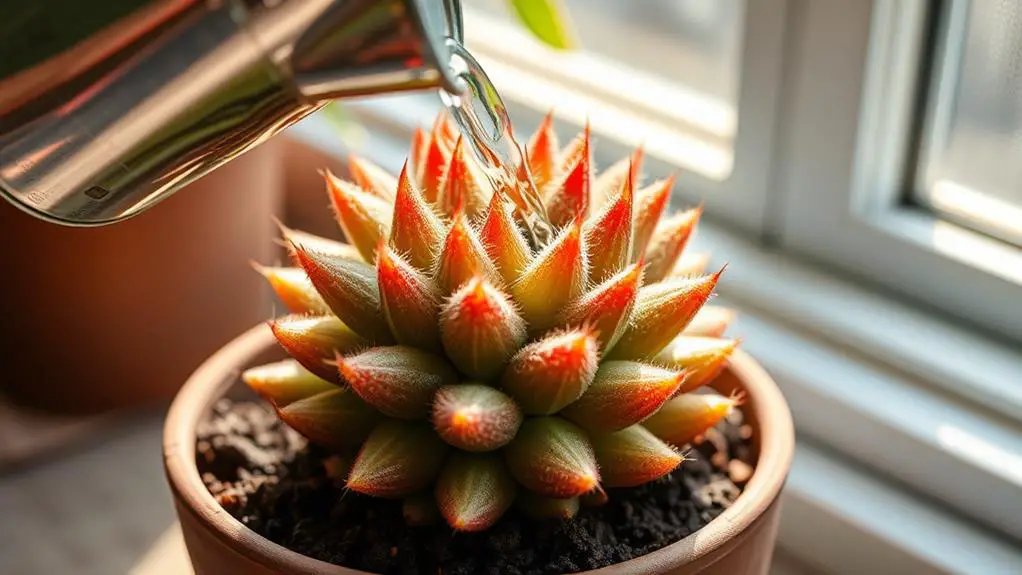
Watering your Anacampseros Telephiastrum Sunrise correctly is essential for its health. Follow these watering guidelines to guarantee your plant thrives.
First, remember to water sparingly. Succulents like the Sunrise need their soil to dry out completely between waterings to prevent root rot. Insert your finger into the soil to monitor soil moisture. If it feels dry, it's time to water.
The recommended watering frequency is about 0.5 cups every 12 days. However, environmental conditions such as temperature and humidity can affect this schedule. During the active growing seasons of spring and summer, you'll need to increase the watering frequency a bit.
In contrast, reduce it to once a month when the plant goes dormant in winter.
Always use room-temperature distilled water or rainwater for your Anacampseros Telephiastrum Sunrise. This avoids shocking the plant with extreme temperature changes and guarantees it gets the best possible hydration.
Allow the soil to soak thoroughly but avoid waterlogging. Overwatering is a common mistake, and it's better to err on the side of caution.
Soil and Fertilizer
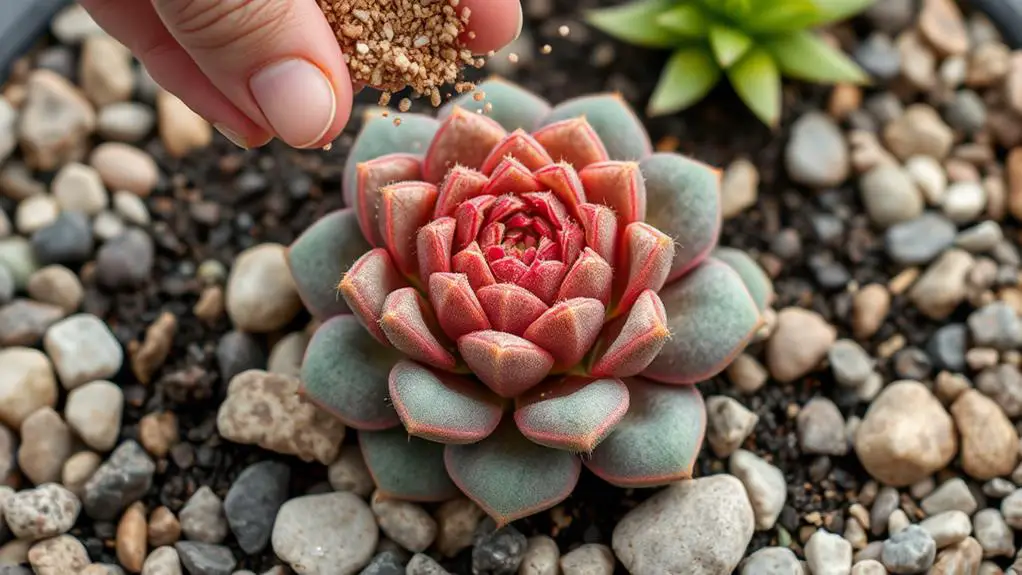
When it comes to soil and fertilizer, your Anacampseros telephiastrum Sunrise will thrive in well-draining soil, like a cactus mix with added perlite or sand.
It's best to stick to nutrient-poor soil and only use a diluted balanced fertilizer once a month during the growing season.
Repotting once a year or when the plant doubles in size helps keep the soil fresh and guarantees good drainage.
Ideal Soil Composition
Anacampseros telephiastrum Sunrise flourishes best in well-draining soil that's specifically designed for cacti and succulents. This type of soil typically includes a cactus mix with added perlite or sand to help water pass through quickly, preventing waterlogging.
It's essential to use soil that's low in nutrients since this plant thrives in poorer conditions. Overly rich soil can actually hinder its healthy growth.
When you're potting your Anacampseros, make certain to use a container with drainage holes. These holes are important because they let excess water escape, which helps prevent root rot—a common issue for succulents.
Repotting should be done when the plant doubles in size or annually. Always use fresh, well-draining succulent or cactus mix to support its growth.
Here are some quick tips to keep in mind:
- Use a cactus mix: Verify the soil includes perlite or sand.
- Check for drainage holes: Always pot in containers that allow water to escape.
- Repot annually: Use fresh, well-draining mix each time.
- Avoid rich soil: Stick to low-nutrient soil for best results.
Fertilization Best Practices
In addition to selecting the right soil, proper fertilization is key to maintaining the health of your Anacampseros telephiastrum Sunrise. While this plant thrives in nutrient-poor soil, you don't need to fertilize it frequently. Generally, the initial potting soil provides ample nutrients.
However, during the growing season, a light application of diluted balanced fertilizer at half strength once a month can support healthy growth without causing root burn.
Make certain you use well-draining soil, like a cactus mix combined with perlite or sand, to prevent nutrient retention issues and guarantee proper drainage. This setup helps avoid over-fertilization, which can harm your plant.
During the dormant winter months, it's best to skip fertilization to allow the plant to rest naturally.
To guarantee your Anacampseros telephiastrum Sunrise remains healthy, regularly monitor the soil's nutrient levels. If you notice yellowing leaves or poor growth, it might indicate nutrient deficiencies.
Adjust your fertilization practices accordingly, but always be cautious to avoid over-fertilizing. Remember, a little care goes a long way in keeping your plant vibrant and thriving.
With these tips, your Anacampseros telephiastrum Sunrise will continue to grow beautifully.
Temperature and Humidity
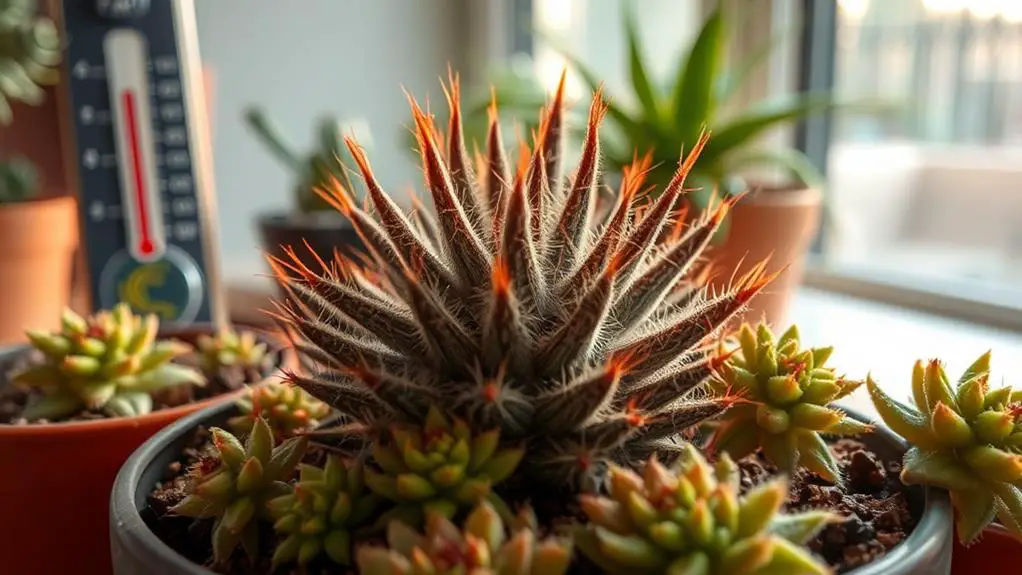
To keep your Anacampseros telephiastrum 'Sunrise' happy, aim for a warm environment with temperatures between 65°F and 80°F.
This succulent isn't cold-hardy, so be sure to protect it from freezing temperatures below 30°F.
It also prefers lower humidity levels of 30-40%, making it perfect for most indoor settings without risking fungal issues.
Ideal Temperature Range
For ideal growth and health, your Anacampseros telephiastrum Sunrise should be kept within a temperature range of 65°F to 80°F (18°C to 27°C). This range guarantees excellent growth, keeping your plant happy and thriving.
Anacampseros Telephiastrum isn't cold hardy, so it's essential to protect it from freezing temperatures below 30°F (-1.1°C). Freezing can cause severe damage, impacting the overall wellbeing of your plant.
Key Temperature Tips:
- Maintain stable temperatures: Avoid sudden temperature fluctuations, as these can stress the plant.
- Warm, dry conditions: Keep your Anacampseros in warm dry conditions to prevent fungal diseases.
- Low humidity levels: With a preference for 30-40% humidity, this succulent is perfect for most indoor environments.
- Indoor protection: Especially during colder months, make sure your plant is kept inside to protect from freezing.
Keeping these tips in mind will help you provide the best environment for your Anacampseros Telephiastrum.
Humidity Level Requirements
Maintaining the right humidity levels is vital for the health of your Anacampseros Telephiastrum Sunrise. This succulent thrives in lower humidity levels, ideally between 30-40%, which mimics its native dry environments. High humidity can lead to fungal diseases, so you'll want to guarantee well-ventilated conditions to keep your plant healthy.
The plant prefers warm, dry environments with a preferred temperature range of 65°F to 80°F for best growth. It's not cold hardy and should be protected from freezing temperatures below 30°F to prevent damage. Monitoring humidity and temperature is essential to avoid stress signs, such as yellowing leaves or poor growth.
Here's a quick reference table to help you:
| Condition | Ideal Range |
|---|---|
| Humidity Level | 30-40% |
| Temperature Range | 65°F – 80°F |
| Cold Protection | Above 30°F |
| Ventilation | Well-ventilated |
| Stress Signs to Watch | Yellowing leaves, poor growth |
Potting and Repotting
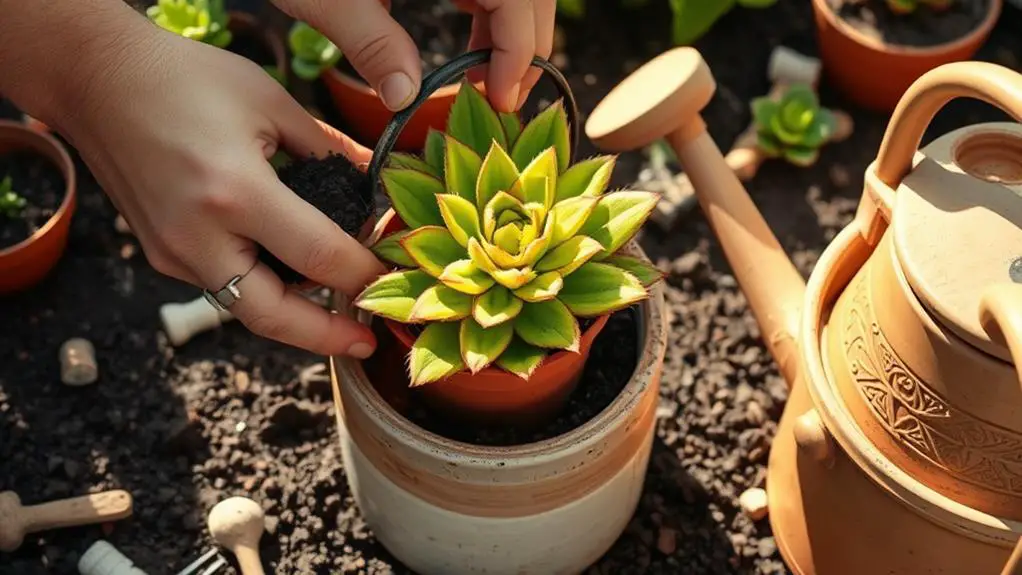
When potting and repotting your Anacampseros telephiastrum Sunrise, start by selecting a well-draining container with drainage holes. A porous material like terracotta or ceramic works best, enhancing moisture control and preventing root rot.
Repot your plant when it doubles in size or annually to maintain its health.
Gently remove the plant from its old container, being careful not to damage the roots. Inspect the roots and trim any dead or rotting parts to promote healthy growth.
Spread the roots evenly in the center of the new pot for stability. Fill the container with fresh soil, burying the roots slightly to encourage strong growth.
After repotting, water the plant lightly to help the soil settle. Avoid placing your Anacampseros telephiastrum Sunrise in direct sunlight for a few days to reduce stress.
Here are some key points to remember:
- Choose a well-draining container: Terracotta or ceramic with drainage holes.
- Repot annually or when the plant doubles in size: Guarantees continued health.
- Inspect and trim roots: Remove any dead or rotting roots.
- Water lightly and avoid direct sunlight after repotting: Reduces stress and encourages stability.
Following these steps will help your Anacampseros telephiastrum Sunrise thrive.
Pruning Techniques
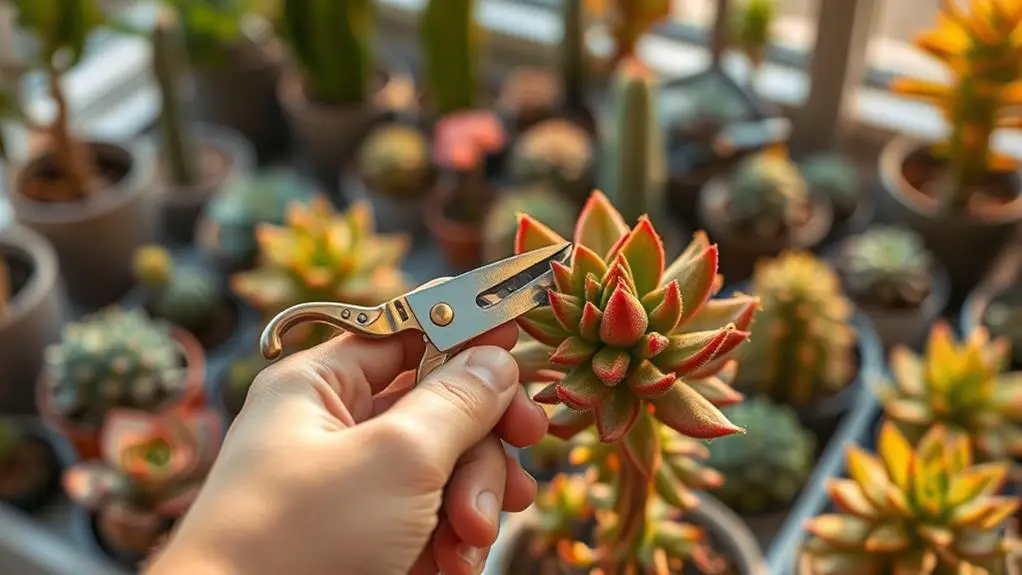
Pruning your Anacampseros telephiastrum Sunrise is vital for maintaining its health and appearance. Start by using clean, sharp pruning shears or scissors to avoid infecting the plant. You'll want to trim away any discolored or damaged leaves first, as they can hinder the plant's overall health.
Regularly pruning spent flowers encourages new growth and redirects the plant's energy towards producing healthier foliage. If you notice any leggy growth, prune it at the base of the stem. This will promote a bushier development and help maintain a compact shape.
Keeping your plant neat and tidy is important, so inspect it periodically for overcrowding. Removing excess offsets guarantees there's enough space and air circulation for healthy growth.
After pruning, it's imperative to give your Anacampseros telephiastrum Sunrise some time to recover. Avoid direct sunlight for a few days to prevent added stress from intense light. This recovery period helps the plant bounce back stronger and healthier.
Propagation Methods
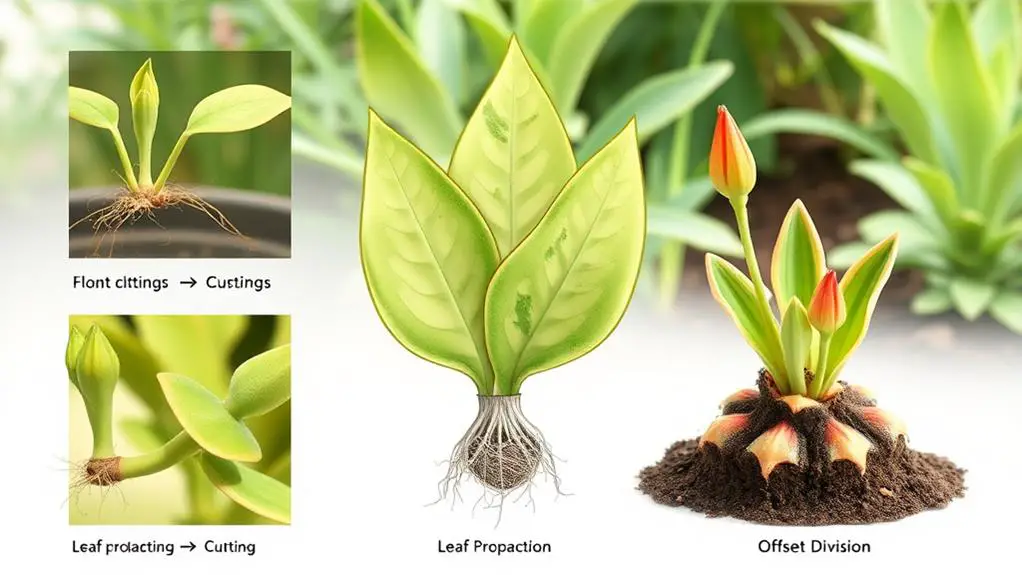
After ensuring your Anacampseros telephiastrum Sunrise is well-pruned and healthy, you might want to expand your collection or share this beautiful plant with friends.
There are several effective methods to propagate Anacampseros Telephiastrum, each with its unique steps.
- Offsets: Separate small plants at the base during repotting. Let the cut ends dry for a day or two before planting them in well-draining soil.
- Leaf Cuttings: Take healthy leaves, allow the cut ends to callus for 1-2 days, then lay them flat on a pre-moistened cactus mix until roots develop.
- Stem Cuttings: Cut a healthy stem, let it dry for a couple of days, and then plant it in well-draining soil. Only water when the soil is dry to prevent overwatering.
- Seeds: Harvest tiny seeds from dried pods and sow them in a warm, moistened seed-starting medium. Germination typically occurs in 5-7 days.
Always monitor moisture levels closely for all propagation methods. Overwatering can lead to rot before roots have a chance to develop.
Common Problems
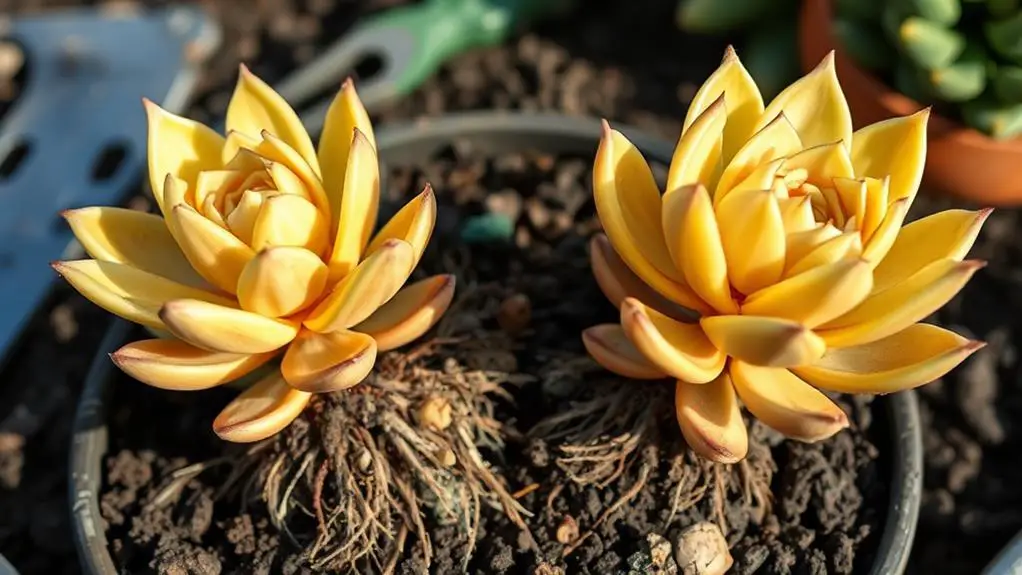
Caring for Anacampseros telephiastrum Sunrise can be straightforward, but it's essential to be aware of potential issues that may arise. Overwatering is the most common problem, leading to root rot. Make sure the soil dries out completely between watering sessions. On the flip side, underwatering can cause leaves to shrivel and wrinkle, so adjust your watering schedule if you notice these symptoms.
Sunburn can occur from too much intense sunlight. To prevent this, gradually acclimate your plant to increased sunlight. Regularly check for pests like aphids and mealybugs. If you spot them, insecticidal soap or neem oil can help. Yellowing leaves usually indicate watering issues or nutrient deficiencies. Evaluate your watering practices and consider using a diluted fertilizer if needed.
Here's a quick reference table to help you identify and solve common problems:
| Problem | Symptoms | Solution |
|---|---|---|
| Overwatering | Root rot | Let soil dry between waterings |
| Underwatering | Shriveled, wrinkled leaves | Adjust watering schedule |
| Sunburn | Brown, crispy leaves | Gradually acclimate to sunlight |
| Pests | Presence of insects | Use insecticidal soap or neem oil |
| Yellowing Leaves | Discolored foliage | Check watering and nutrient levels |
Frequently Asked Questions
How Do You Care for Anacampseros Telephiastrum Sunrise?
You should place your Anacampseros Telephiastrum Sunrise in bright, indirect light, water only when soil's dry, use well-draining soil, fertilize monthly during growth, and watch for pests. Avoid overwatering and too much direct sunlight.
How Often Should I Water Sunrise Succulents?
Water your Sunrise succulents every 10-14 days, letting the soil dry completely between waterings. In summer, increase frequency, and in winter, reduce to once a month. Always check soil moisture and use room-temperature distilled or rainwater.
How to Grow Anacampseros?
To grow Anacampseros, place it in bright, indirect light for 5-6 hours daily. Use well-draining soil, water every 12 days, and let cuttings callus before planting. Monitor for pests and maintain 30-40% humidity.
How to Grow Sunrise Succulents?
To grow Sunrise succulents, place them in bright, indirect light for 5-6 hours daily. Water sparingly, letting soil dry between waterings. Use well-draining soil, maintain temperatures between 65°F-80°F, and keep humidity around 30-40%.
Conclusion
Caring for your Anacampseros Telephiastrum Sunrise can be simple and rewarding if you follow the right steps. Give it bright, indirect light, water sparingly, and use well-draining soil. Keep the temperature comfortable and avoid high humidity. Repot annually and prune with clean shears. Don't forget, you can propagate through offsets or cuttings. With patience and care, your plant will thrive, adding a touch of beauty to your space. Happy gardening!

